This post is part of a draft on palaeolinguistics and the Proto-Uralic homeland. See below for the color code of protoforms.
10. Metallurgy
PU (Saa., Fi., Md., Ma., P, Ms.?, Kh., Smy.?) *wäśkä (*waśki?) ‘copper; ore, brass’ (UEW Nº 1123; Kallio 2006: 6). Irregular cognates suggest it might have been borrowed during the split-up of Proto-Uralic (cf. Aikio 2015: 42). However, compare potentially regular cognates from *wäskä in PFi. *vaski ‘ore, copper, bronze; brass’ (Kallio 2012: 167; Zhivlov 2014: 115), PSaa. *weśkä ‘copper; brass’, Md. Kazhlodka viśkä ‘chain’ (Häkkinen 2012: 18), and possibly Hu. *vas ‘iron’ (Zhivlov 2013), while Kh. wăγ, wăχ would display a regular *sk → *ks → γ. In compounds, cf. PMa. *wåž ‘ore’; PP *äz-veś ‘silver’ (← Pre-PP *äsä-wäśkä, cf. Csúcs 2005: 321; J. Häkkinen 2009: 25-28); Ms. k, khw may have been secondary *w → k˳ → k, with a dialectal phenomenon seen in other examples.
Aikio (Aikio 2015) considers the reconstructible Smy. protoform *wäsa ‘iron; metal; money’ a disharmonic shape, compared to the expected regular PU *wäśkä → PSmy. **wäsä. The Smy. protoform was probably borrowed into PToch. *wesa ‘gold’, a form which cannot be easily reconciled with PIE (Driessen 2003, Kallio 2004: 132-133), contra Adams (2013: 525), who proposes an underlying **hₐwesehₐ, from PIE *h₂eus- ‘dawn’. This PSmy.-PToch. loan would set a quite early terminus ante quem for the presence of the term in the Samoyedic branch, given the known early Pre-PSmy. ~ Pre-PToch. contacts.
NOTE. Proposed to be formed by an underlying *wäśä and PU suffix *-ka/*-kä. Further proposed to derive as a loan from PIIr. *waćī ‘axe, pointed knife’ (Carpelan & Parpola 2001: 127), in turn suggested to be part of the Agricultural Substrate (Lubotzky 2001: 312). The proposal is semantically and phonologically unattractive, and the PIIr. form was probably ultimately from PU *weŋći ‘knife’ (Parpola 2012: 161), which would render the reversed PIIr. loan chronologically untenable, in light of the reach of the word compared to those of the PIIr. layer. Viitso (2012: 196) proposes an ultimate origin in NW Caucasian, based on a second component (*ƛ̣ʷV ‘blue, green; iron’) found in some compound metal names, cf. Ubykh *wǝc̣ʷá (Viitso 2012: 19). Similarly, Bjørn (2017: 73) compares it with a more specific NW Caucasian *γʷeč’a ‘iron’. Semantically possible, the hypothesis – while attractive for archaeological reasons – remains formally untestable due to the lack of any other similar examples, or at least a reliable chronology and reconstruction for NW Caucasian and its dialects.
The word has been traditionally considered a Wanderwort for different reasons: cf. Pictet (1859), Aalto (1959: 36), for an origin in Arm. oski; G.S. Lane (1970), Joki (1973: 339-340) for an origin in PToch. (later Lane would reverse the direction of borrowing). Aikio (2015: 42) considers *waśki the regular reconstruction for PFi. *vaski, PMd. *uśkǝ (from MdE uśke, MdM uśkä) and Hu., contrasting with PSaa. *veaškē and the irregular PSmy. form, hence the set as a whole a “Wanderwort that has separately entered the already differentiated branches of the family”. However, PFi. and PMd. follow – admittedly marginal – phonological rules underlying the evolution of other examples, and so does Hu. Furthermore, it is not immediately clear why Aikio would prefer to consider this quite homogeneous and widespread set as a “Wanderwort” – a concept later repeated in Holopainen (2019, passim) – instead of a “substratum”, which would make much more sense based on the lack of external (coeval) Eurasian cognates and on the many other sets proposed to contain similar phonological irregularities (Aikio 2015). In particular, it is unclear what makes each of these words related to the Neolithic package different from other irregular sets deemed likely PU (cf. Aikio 2020: 30-32 for ‘father’; and 2000:57-58 and further 2019:47-48 for ‘spirit, soul’). All in all, most likely a Proto-Uralic word, probably related to the Agricultural Substrate based on similar phonological irregularities described for it, and on other likely contemporaneous words of the set (see below).
PFU (Ma., Kh., Ms., Hu.) *wolnV ‘tin’ (UEW Nº 1162).
PFU (Fi., P, Kh., Hu.) *weŋći ‘knife; to cut’ (UEW Nº 1132; Holopainen 2019: 393). Probably borrowed into PIIr. *waćī ‘axe, pointed knife’, cf. OInd. vā́ćī-,? YAv. vāsī- ‘pointed knife (?)’ (Lubotsky
2001; Parpola 2012: 161; Kümmel 2019; Holopainen 2019: 393) during the evolution *n̥ → (*ᵊn → *ã →) *a.
PU (Saa., Fi., Md., Ma., Kh., Ms., Smy.) *ćüδ́i ‘coal; charcoal’ (UEW Nº 961; Aikio 2020: 146-147 with references), replaced in Pre-P *äŋkärä ‘coal’ ↔ PIIr. *angāra-, cf. O.Ind. áṅgāra- ‘coal’, not present in Iranian (Holopainen 2019: 321 with references).
PFP (Fi., Md., Ma.) *wala-/*wälä- ‘to pour; to cast (metal)’ (UEW Nº 1685), suspected by Aikio (2015: 46) to belong to the Agricultural Substrate based on its “distribution, meaning and phonological irregularity”(?).
PFU (P, Ms., Hu.) *pänV ‘grindstone; to grind’ (UEW Nº 728).
PFP (Fi., Ma., P) *taško/*tašV/*tuškV ‘grindstone; back of a knife or an axe’ (UEW Nº 1634). Suspected to belong to the Agricultural Substrate based on the *š and irregular correspondences (Aikio 2015: 45).
PWU (Saa., Fi., Md.) *šamara/*šimara/*šowV ‘butt’ (UEW Nº 1608). Suspected to belong to the Agricultural Substrate based on the *š and irregular correspondences (Zhivlov 2015).
NOTE. Zhivlov compares it with PGmc. hamara- ‘hammer’, although the Germanic form has a more attractive etymology in a metathesized LPIE *kah-mo- ← *hak-mon- ‘heavenly vault, anvil, meteorite’, cf. PSlav. *kamy ‘stone’, Gk. kamára ‘vault (Kroonen 2013).
PWU (Saa., Fi., Md.) *šija-/*šijo-/*šiwa- ‘to grind, to whet’ (UEW Nº 968; Aikio 2015:45).
PFP (Fi., P) *šVra ‘grindstone; to grind’ (UEW Nº 1611; Aikio 2015:45).
PFP (Saa., Fi., Md., P) *pišti/*pikši ‘pliers, splint holder’ (UEW Nº 1492; Aikio 2015:45).
PWU (Fi., Md.) *raško ‘forked thing, splint holder’ (UEW Nº 1518; Aikio 2015:45).
PWU (Saa., Fi., Md.) *waćara ‘axe?; hammer’ (UEW Nº 1693) ← PIIr. *wáʒ́ras (cf. Av. vazra- ‘club’, O.Ind. wáʒ́ras ‘thunderbolt, Indra’s weapon’). Because of the *ć it cannot be a borrowing later than the PIIr. stage. Based on *wäska and this word, Fi. and Md. forms could be described as regular cognates (Häkkinen 2009: 23-24), but there is no obstacle in assuming that they represent separate borrowings into the early proto-languages, either. Probably originally a religious loan, later reinterpreted as a common tool (Holopainen 2019: 292-293 with references).
NOTE. The assumed underlying PIE *wog-ro-, behind Gmc. *wakra- ‘alert, awake’, from *wakan ‘to be incited’, cf. Lat. vigil ‘alert’ (Kroonen 2013: 568), is semantically uncompelling for the PIIr. form. On the other hand, my proposal of a possible borrowing from Uralic (?Pre-PMd. *waź- → PIIr. *waʒ́-) is not particularly attractive, either, due to the potential irregularity of the Uralic cognates (depending on *wäskä, see above) and lack of similar examples or a proper (absolute) chronological description of PU → Pre-PMd. → PMd. developments. The output and distribution are regular if we assume a Uralic loanword from PIIr., which renders it the most likely direction of borrowing.
PFU (Saa., Fi., Md., Hu.) *ora ‘awl’ (UEW Nº 676) ← PIIr. *ārā (cf. O.Ind. ā́rā ‘awl’), also in Gmc. *alaz (← *ṓlos). Not found in Iranian (Holopainen 2019: 163-164 with references).
PFP? (PMd. ~ PMa.)? *kürtńV ‘iron’ (UEW Nº 1287) ← P(I)Ir. *kártana- ‘cut’, P(I)Ir. *kr̥tí- ‘dagger’ → PP *kȯrt ‘iron’; PMs. *kīrV ‘iron’ and PKh. *kǟrtV ‘iron’ ← P(I)Ir. *kárt-a ‘knife, dagger’.
PFP? (PMd. ~ PMa.)? *serńä ‘gold’ (UEW Nº 1746) ← PIr. *dzəranja- ‘gold’ → PUg. *si̮r(a)ńa ‘gold, metal’, probably present in PKh. and PMs., also later into PP (Holopainen 2019: 232-233, 234 with references).
Metalworking in archaeology
It is evident from the set above that the Proto-Uralic community knew metals and metalworking (Kallio 2017: 191; Saarikivi 2020: 73), whether the metallurgical PU vocabulary was natively Uralic or adopted from its neighbours. What is remarkable about the Proto-Uralic vocabulary pertaining to this field is the lack of clear Pre-PIIr. cognates – with one compelling example of early borrowing in the other direction, *weŋći. This contrasts with other farming and technological sets, and with the later massive influence of PIIr., contradicting the idea that they learnt metallurgy first in their contacts with Indo-Europeans.
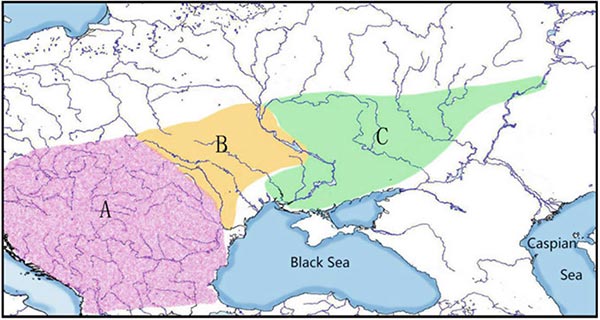
Marginal area (the Tripoliye-Kukutani culture); C. Peripheral area (Eastern European steppe). Image modified from Yang, Shao, & Pan (2020), in turn adapted partly adopted from the course material named Archaeology of Russia, Central Asian and Mongolia delivered by Professor Hanks.
After the disintegration of the Late Trypillian culture (Videiko 2011) and the start of its Dark Age, a ‘Caucasian reorientation’ of the North Pontic metallurgical center took place, with steppe populations gearing towards Maykop: first with the Zhivotilovka-Volchansk group/type (horizon?), and then with the Yamnaya and later ‘Ingul-Donets’ EBA civilization center, which formed first in the second half of the 4th millennium BC (Klochko & Kośko 2013).
The lack of a common influence with PIE/Pre-PIIr. on this particular vocabulary might suggest that, unlike other early Yamnaya-related cultural waves pertaining to cart, wheel, or animal husbandry, metallurgy by Pre-PIIr. speakers of Catacomb-Poltavka did not affect the disintegrating PU community as strongly, which in turn supports that words like *weŋći, *wäśkä (*waśki?), and the rest of the metallurgical set including the Agricultural Substrate was present in Proto-Uralic or Disintegrating Uralic before the Pre-PIIr./PIIr. layer, hence most likely related to an early metallurgical center close to the Pontic-Caspian steppes.
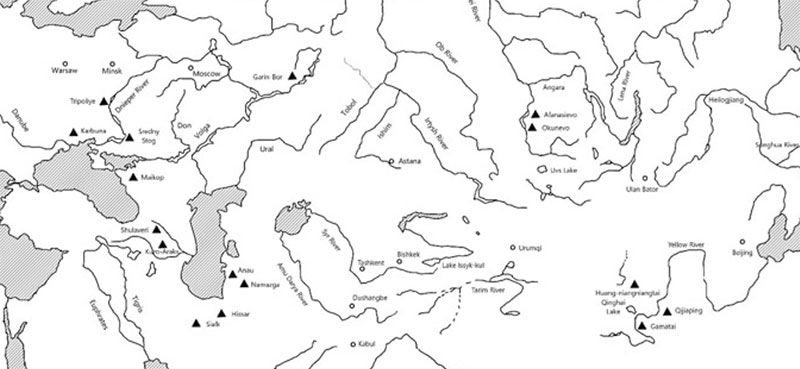
In the Volga-Kama area, in Siberia, and Northern Asia, the first contacts with metallurgy were driven by the Circumpontic Metallurgical Province, with Yamnaya-Afanasievo influence and mines reaching in the late 4th millennium / 3rd millennium BC the Cis-Urals (Koryakova & Epimakhov 2007: 28-33) and the Altai (Yang, Shao, & Pan (2020): 16-19). Pre-PIIr.-speaking Poltavka herders settled the ore-rich Volga-Ural and Ural-Tobol region ca. 2800-2600 BC (Anthony 2007), well before they admixed with Abashevo settlers during the formation of the Proto-Indo-Iranian community. This continued presence of metalworking PIE/Pre-PIIr.-speakers and the lack of early linguistic influence helps discard the presence of the Proto-Uralic or Disintegrating Uralic community around the steppes by that time, and locates it rather to the west or north of the community.
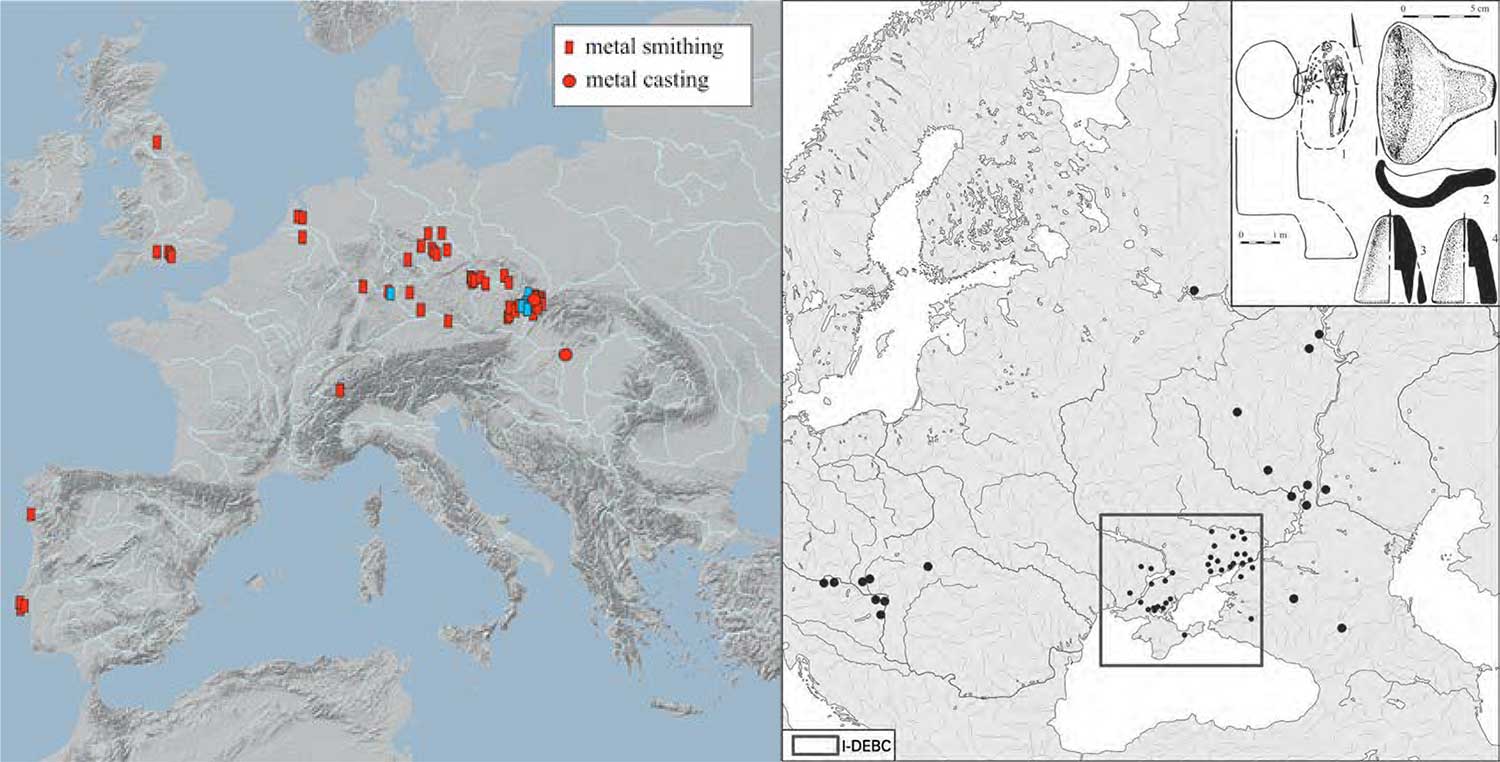
To the north of the Pontic steppes, the Carpathian Volhynia EBA center of Metallurgy took shape within the Corded Ware culture of the Dniester drainage basin on the basis of the Trypillian cultural metallurgy, as its south-eastern part was exploited by Yamnaya and Catacomb (Klochko 2017: 226-245). Later, metalworking accompanied the appearance of the Catacomb-related newcomers that formed the Niche-Grave group of Małopolska in the mid-3rd millennium BC (Kośko & Włodarczak 2018), signaling the potential intrusion of Pre-PIIr.-speaking groups into the forests, which – judging by modern derivatives – might have been associated with some quite early loanwords in Disintegrating Uralic or in West Uralic (see above). This late incursion of a Yamnaya-related population is also visible in population genomics.
In North-Eastern Europe, whereas most of Fatyanovo remained poor in metal, its south-eastern Balanovo territory developed into a metallurgical center, obtaining raw material from copper-bearing sandstones of the Kama River valley and the western Ural Mountains – replacing thus the recently developed primitive Garino-Bor metalworking activity (Anthony 2007: 377-382; Yang, Shao, & Pan 2020: 16-19; Nordqvist & Heyd 2020: 13). To the south-east of the Pontic-Caspian steppes, in the Zeravshan valley, East Yamnaya/Poltavka had already started commercial contacts with Sarazm well before the emergence of Sintashta-Petrovka, which is visible in the metallurgical objects of likely Circumpontic origin, and in the mixed ceramic traditions of Kelteminar, Sarazm, and Yamnaya-Afanasievo origin (Avanesova & Kasparov 2020).
Furthermore, there is evidence of cultural contacts beyond trade, illustrated by the Zhukov sanctuary (Avanesova 2012: 8-27), a site of religious nature signalled by significant areas of burning along with boulder-sized stele, which apparently performed an intermediating function or the “connecting of worlds” (Golan 1993, p. 41), in construction traditions reminiscent of Afanasievo, West Yamnaya, and Bell Beaker constructions. This strong cultural influence of the Volga region despite a lack of genetic influence attests to the tight connection of religion and metallurgy in the Early Bronze Age. In fact, there is a counter-intuitive limited intrusion in the opposite direction, of a Kelterminar-related population in the Lower Volga, at the same time as Poltavka expanded eastward, which might justify the earliest contacts of (Pre-)PIIr. with the Asian Agricultural Substrate.

11. Mythology
11.1. Pantheon
PFU (Saa., Fi., P, Kh., Ms.) *jilma ‘sky, weather; (Fi., P) god’ (UEW Nº 146).
PEU? (Kh., Ms., Smy.) *numi ‘upper part, top, upper; sky; god’ (UEW Nº 604).
PFP (Fi., Md., Ma.) *juma ‘god’ (UEW Nº 1253) ← PIIr. *djumnám ‘divinity’ (cf. O.Ind. dyumná- ‘divinity, divine glory’, O.Av. diuuamnəm ‘id.’), from PIE *djḗus ‘sky, heaven; sky god’, the main god of the PIE pantheon. It could also be from an earlier Pre-PIIr. *djumnó- (Holopainen 2019: 107-108 with references).
NOTE. The assumption by Parpola (2015: 66, 109; 2019) that a PFP (Fi.? P?) **Jilma-ri? is behind PIIr. *Índra (cf. O.Ind. Índra ‘war-god’, Mitanni ᵈIn-da-ra-, Y.Av. Indra- ‘name of a Daeva’) is phonologically and chronologically uncompelling (Holopainen 2019: 389). The PIIr. god has its most likely origin in the Asian Agricultural Substrate (Lubotsky 2001, 2010). That rejection notwithstanding, the reconstruction of PU noun *itäri ‘clear, clearing’ behind NenT ŋǝďer, if it is in fact an archaism (Aikio 2019: 66), would mean that the suffix *-ri could be reconstructed for Proto-Uralic.
PFU (Md., P., Ms.) *asora ‘lord’ (UEW Nº 29) ← PIIr. *ásura- , cf. O.Ind. ásura- ‘godlike, powerful’, Av. ahura ‘god, lord’ (Holopainen 2019: 70-71 with references; Aikio 2020: 29-30). The original meaning of *h₂(e)ms-u- seems to be ‘lord’, cf. Hitt. ḫaššu- ‘king’, O.Av. ahu ‘lord’ (Kloekhorst 2008: 327-328), but the religious meaning might be reconstructible for Late PIE, too; cf. PGmc. *ansuz ‘deity, god’ (Kroonen 2013: 30).
Pre-PHu. *suri/*sura (cf. Hu. úr ‘lord, gentleman’) ← (Pre-)PIIr. *su-Hrí-, cf. O.Ind. sūrí- ‘offerant, lord, patron’. Not cognates outside Indo-Aryan, but both components are found in Indo-Iranian and are reconstructible for PIE. The loan predates the sound change PU *s → PEU/PUg. *θ or *l, from where Hu. *ø (Holopainen 2016; Holopainen 2019: 237-238).
PWU (Saa., Fi., Md.) *jama/*je̮ma ‘twin’ (UEW Nº 1253) ← PIIr. *jamá- ‘twin; divine twin’ (Holopainen 2019: 101-102 with references).
Pre-PFi. *tajwas ‘sky, heaven’ ← P(I)Ir. *daiwás ‘heaven, god’. It could also be a borrowing from Baltic, but PIIr. fits better with the religious set. Same root behind Pre-PFi. *tojwa- ‘wish’ (see below), maybe because of the alternating PIIr. *dāiwás (Holopainen 2019: 270-271 with references).
Pre-PMd. *pakas (*paxas) ‘god’ ← P(I)Ir. *b(ʰ)aga-s ‘god, luck’ (Holopainen 2019: 171-172 with references).
11.2. Cosmology
PU?/Pre-PFi. *sampas ‘pillar’ ← P(I)Ir *stambʰa-s ‘post, pillar, column’ cf. O.Ind. stambʰa-, O.Pers. stabava-, Av. Ni. stəmbana-. Pre-PSaa. *sompa/*sampi probably belongs here, too, but it could also be from an earlier PIE/Pre-PIIr. *stombʰo- (cf. PToch. *stəma-). One way or another, the set supports succeeding layers of similar PIE/Pre-PIIr./PIIr. borrowings replacing previous ones (Holopainen 2019: 211:213 with references). Proto-Indo-European mythology includes the concept of a ‘world pillar’ that holds the ‘stone sky’ (Fortson 2010), and the word Stambha has still today the value of a cosmic column that joins heaven and earth in Hinduism.
PFS (Saa., Fi.) *ćāra ‘brown? to dawn’ ← PIIr. *ćāra- → O.Ind. śāra- ‘colorful, spotted, mottled’. Maybe more likely from a dialectal PBSl. *źoriˀ ‘dawn, sunset, hot coal’ (cf. Lith. *žarà, PSlav. *zaŗà), hence unrelated to these religious themes (Holopainen 2019: 75 with references).
POUg. *wāta ← ‘wind’ P(I)Ir. *wāta- ‘wind’ (Holopainen 2019: 302 with references). Due to the distribution of the word, it probably belongs to the PIIr. layer.
NOTE. This word has been famously used (cf. Kümmel 2004, Fortson 2010) to justify the survival of a “laryngeal hiatus” supposedly reflected in Avestan and Vedic texts as PIr./PIAr. **(ˀ)wa(ˀ)ata- ‘wind’ ← PIIr. **(H)wa(H)ata-. Even though laryngeal remnants might have been present in certain environments (like those retaining sonorants e.g. in this case as Early PIIr. **waˀn̥tas → **waˀãtas?, the assumption by Holopainen (2019:302 and elsewhere) that laryngeals could have been present in many (Pre-)PIIr. words but not reflected in PU loans (with some exceptions like *saxi??), seems to add to this circular reasoning about late, independent, and always almost attested laryngeal loss events in Indo-European studies, instead of helping delimit it with external comparisons. Based on many other examples, there seems to be no solid reason to justify the presence of laryngeals in Proto-Indo-Iranian, although in this case the proposed laryngeal hiatus could have conceivably not been adopted from the source word.
POUg *θē̮ra (UEW Nº 1747) ←? Pre-PUg. *sara(*sora?)/*šara ‘sea’ ~ PIIr. *sáras- ‘sea, lake’ → PP *sar ‘sea’ (Holopainen 2019: 217-218, with references).
NOTE. Compare also Komi sarid’ź ‘sea’, Udmurt zarid’ź ‘sea; a warm (southern) region where birds migrate for winter’ ← Iranian *zraya- (← PIr. *dzraya-) → Av. zraiiah-, O.Pers. drayah- ‘sea’. It is dubious that Fi. sarajas ‘mythological river in the land of the dead’ (only found in old folk Finnish poetry) belongs to one of the two above, but it is phonologically and chronologically possible (Holopainen 2019: 218-219 with references).
11.3. Soul & Death
PU? (Saa., Smy.) *wajŋi ‘breath; soul, spirit’ (UEW Nº 1107). According to Aikio (2019: 47-48), this ‘breath-soul’ concept would be different from PU? (Saa., Fi., Md., Ma., P. Kh., Ms., Hu.) *ić(ć)V/*jić(ć)V/*äć(ć)V/*ećV? ‘spirit, soul’ (UEW Nº 142), which would refer to the ‘shadow-soul’, thought to be able to leave the body during dreaming, unconsciousness, or a shaman’s spirit journey.
NOTE. In all branches except Ugric, the ‘shadow-soul’ concept would have become the root of the reflexive pronoun: ‘one’s soul’ → ‘oneself’, an evolution paralleled by the replacement of the inherited reflexive PIIr. *s(u̯)á- by PIIr. *tanū́- ‘self’ ← ‘body’.
PFP (Md., Ma., P, Hu.?) *ćoma- ‘get tired; die out(?)’ (UEW Nº 974) ← PIIr. *ćam- (cf. O. Ind. śamⁱ- ‘to be extinguished, die out’) ‘to be extinguished, die out’ → PFi. *sammu ‘to be extinguished’ (but maybe from PGmc. *stammian-). The Hungarian adjectives are later derivatives (Holopainen 2019: 210-211, 213 with references; Aikio 2020: 135-136).
PFU (Ma., Hu.) *soŋka/*saŋka/*se̮ŋka ‘old’ (UEW Nº 907) ← PIIr. *sana-ka- ‘former, ancient’, cf. O.Ind. sanaká- ‘former, ancient’, Lat. senex ‘old’ (Holopainen 2019: 235-237).
PFi. *martas ‘dead’ ← P(I)Ir. *martas ‘dead’ ← PIE *mortos (Holopainen 2019: 137-138 with references).
11.4. “Path”
PWU (Saa., Fil, Md.) *je̮ni ‘path’ ← (Pre-)PIIr. *jān- ‘travel, journey’ (Holopainen 2019: 106-107 with references).
PFP (Ma., P) *puntaksi ‘bottom, basis’ (UEW Nº 1512) ← PIIr. *b(ʰ)udʰna-, cf. O.Ind. budʰná- ‘ground, bottom’ (Holopainen 2019: 194 with references).
PFP (Saa., Fi., Md., Ma., P) *pe̮ra/*para ‘good’ ← PIIr. *paras ‘distant, far, remote; later; foreign’ (Holopainen 2019: 175-176 with references).
PFP (Saa., Ma.) *toras, *toraksi ‘crosswise, through’ ← PIIr. *tarás (Holopainen 2019: 285-286 with references).
11.5. Libation
PWU (Saa., Fi., Md.) *püšä ‘sacred’ (Saarikivi 2007: 327-331; Aikio 2015: 45)
PU (Md., Ma., Ms., Kh., Smy.) *pe̮ŋka ‘psychedelic mushroom’ (UEW Nº 706) ← P(I)Ir. *b(ʰ)anga- ‘narcotic hemp’, cf. Av. baŋha- ‘name of a plant and a narcoticum that is made of it’, without cognates in other Indo-European languages. Most likely ultimately a borrowing from Asian Agricultural Substrate (Lubotsky 2001), it could theoretically be a borrowing from the same source in both (Holopainen 2019: 186-188 with references).
PU *anti/*onta ‘grass; sprout’ (UEW Nº 1190) ← (Pre-)PIIr. *ándʰas- ‘sprout of the soma plant?’, cf. Skt. ándʰas- ‘sprout, sprout of the soma plant’. Dubious correspondence within IE with Gk. antʰos ‘flower, bloom’, which has been connected to the flowering of vine (Dunkel 1995), and assumed to be closely connected to gods and rituals, hence also in Proto-Indo-European (Janda 2000:272-273). Even more dubious is the connection with Alb. endë ‘flour’, or Arm. and ‘field’ (Holopainen 2019: 55-58 with references). If ultimately Proto-Indo-European, it could be an earlier borrowing from PIE *ándʰos-.
NOTE. This original meaning in PIIr. was possibly replaced by the Agricultural Substrate-related *anćúš m. ‘soma plant’ (probably ephedra), cf. Skt. aṃśú ‘Soma plant’; Av. ąsu ‘Haoma plant’ (Lubotsky 2001).
Pre-P *känä ‘hemp’ ← Pre-Ossetic *kænæ?, cf. Oss gæn, gænæ, Mari kәńe, kińe (Holopainen 2019: 381 with references). Probably an Eurasian Wanderwort, possibly spread to the west into Turkic and Uralic with (Pre-)Scythians or Thracians, also possibly behind Gk. kánnabis (later adopted into Vulgar Latin). Some ancient examples suggest that the word was widespread before; cf. Sumerian kunibu and Pre-PGmc. form behind OE hænep, ON. hampr, OHG hanaf (Beekes 2010). An original **kana- probably gave O.Ind. śana- ‘hemp’, while *bʰanga probably referred to a closely related concept, ‘narcotic hemp’.
NOTE. Pre-Grimm Gmc. is also compatible with P(I)Ir. ~ Pre-PFi., see above for *mača- ‘moth. Probably all substratal terms above are derived from BMAC or agricultural groups from Central Asia, known to have heavily influenced Proto-Indo-Iranian (cf. Witzel 2000).
PP *sur ‘beer’ ← P(I)Ir. *súrā-, cf. O.Ind. súrā- ‘beer’, Av. hurā- ‘fermented mare’s milk’. Impossible for it to be Middle Iranian, it must be Early Proto-Iranian the latest, although a Wanderwort through Turkic seems more likely based on Permic vocalism. Adopted in Hu. ser, sör through Turkic, too (Holopainen 2019: 238-239 with references).
PWU (Fi., Md.) *ćämi(-) ‘(to) drink, gulp’ ← Pre-PIIr. *ʒ́ʰeum(e)n- / PIIr. *ʒ́ʰauman- (cf. Skt. hóman- ‘sacrifical pouring, sacrifice’), from PIE *gʰeumn- (Greek χεῦμα ‘that which is poured, stream, pouring, jug’), a common root for libation and sacrifices (Aikio 2020: 114 with references).
Pre-PFi. *peji- ‘to drink; wedding, funeral’ ← Pre-PIIr. *peija-, cf. O. Ind. -paija- ‘drink’, péja- ‘libation’ (Holopainen 2019: 173-174 with references).
For more on archaeological findings of wild and cultivated cannabis, see McPartland, Guy, & Hegman (2018).
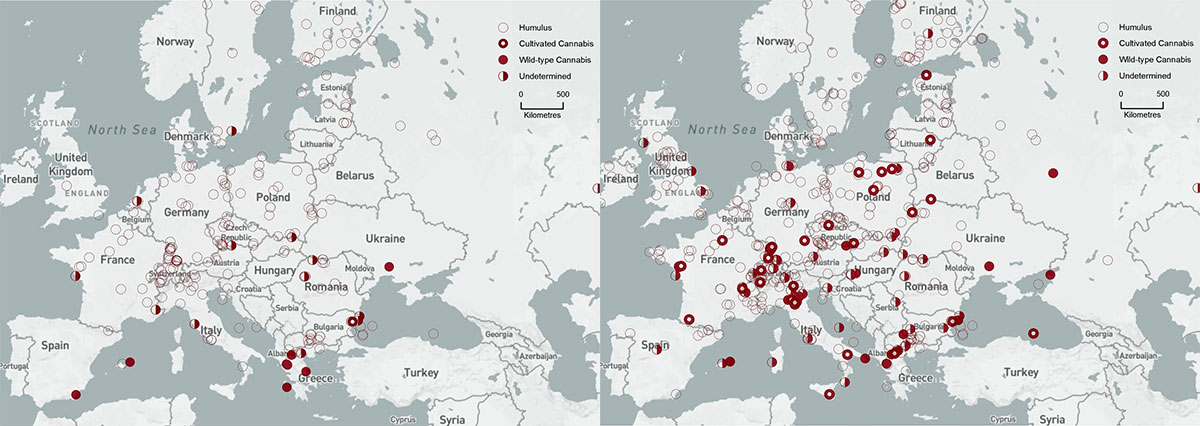
11.6. Sacrificial offering
PFU (Saa., Fi., Ma., Ms., Hu.) *ońća ‘part, share (of meat?); luck’ (UEW Nº 657) ← Pre-PIIr. *onkʲo- or PIIr. *anća-, cf. O. Ind. aṃśa- ‘m. share of a fortune, loot; troop, party; N pr. a son of Aditi (he who has many shares)’, Av. ąsa- ‘part’. PFU *ońćo- ‘to get’ is probably derived from *ońća (Holopainen 2019: 170-171 with references). It could belong here or with earlier vocabulary for animal husbandry or trade (see above).
PU (Saa., Fi., Md., Ma., P, Kh., Smy.?) *ćali ‘gut’ (UEW Nº 972) ←? PIIr. *ćā́lā- (cf. Skt. śā́lā- ‘hut, house, chamber’) relied on the old reconstruction *ćola and the dubious relationship of the PIIr. form with Gk. kolon ‘large intestine’, itself maybe a derivative of PIE *(s)kel- ‘to bend, crook’. The modern reconstructed form might be compatible with an assumed (Pre-)PIIr. protoform **ćal- (←? **kʲol-), but the stem in *-i poses yet another obstacle for the comparison. If correct, one of the few Indo-Iranian loanwords with a distribution stretching to Samoyed, which was also borrowed into Proto-Yukaghir *solije ‘intestine, gut’ (Holopainen 2019: 216-217 with references; Aikio 2020: 100-101 with references).
NOTE. Concerning semantic parallels, Aikio notes Veps perze-koda ‘rectum’ (← PFi *persek ‘ass’ + *kota ‘hut’). However, the lack of a clear semantic relationship with the attested Indo-Iranian form, the Uralic stem in *-i , the curious borrowing of a form in *l from Indo-Iranian, as well as the presence of the loanword in Samoyedic render the words unlikely cognates, albeit none of them is reason enough to reject it. An early borrowing in the other direction wouldn’t be able to explain the PIIr. long root vowel and the stem in *a without assuming the same ad hoc exceptions.
PFP (Md., P) *wärkä ‘kidney’ (UEW Nº 1699) ← PIIr. *wr̥tka ‘kidney’, of an unclear origin; maybe from PIE *wert- ‘to turn’. A borrowing from Uralic into a PIIr. *-rtk- is implausible (Holopainen 2019: 319-321 with references).
(Pre-)PFi. *takra ‘piece of meat’ ← P(I)Ir. *dātrá-, cf. O.Ind. dātrá- ‘gift’, Av. dāθra- ‘gift, offering, alms, loan, sale’ (Holopainen 2019: 271-272 with references).
(Pre-)PFi.? *pe̮rna ‘spleen’ ←? PIIr. *spr̥ʒ́ʰán- / PIr. *spr̥dzan, probably affected (as in Indo-European dialects) by taboo (Holopainen 2019: 181-182 with references).
NOTE. It is impossible to ascertain which words belong here and which to the vocabulary pertaining to animal husbandry and trade (v.s.), if there was ever a distinction, because of the subsequent evolution of religious borrowings as non-religious words (cf. Holopainen 2019: 293) and vice versa. The most likely division between Pre-PIIr. and PIIr. borrowings is difficult to translate directly into a priori non-religious vs. religious words, in light of the (religious?) (Pre-)PIIr. loanwords that might have reached Samoyedic.
11.7. Ritual
PFU? (Saa., Fi., Ms.) *nojta/*nojte̮ ‘shaman; magician’? (UEW Nº 602).
PWU (Fi., Md.) *uni ‘dream’ (UEW Nº 1655) ←? PIE/Pre-PIIr.? *on-r̥, *on-er-io- ‘dream’, cf. Gk. onar, Arm. anurj, Alb. Tosk ëndërrë.
NOTE. Janhunen (1981: 231-232) derives *uni from Pre-PU *oni, from an internal evolution Finno-Ugric *o → *u /_Ci (while Samoyedic preserves the original vowel), which would render the comparison regular. However, Aikio (2020: 88) questions the validity of this sound law, and proposes a relationship with PU (Fi., P, Smy.?) *wuni ‘forget’ (UEW Nº 1176) without further explanation. In any case, chance similarity of the PU ~ PIE forms seems at least as bad a solution as a rare ad hoc internal sound law.
Pre-PFi.? *šerä- ‘to wake up’ ← Pre-PIIr. (or “Pre-PIr.”) *džer- (Holopainen 2019: 258-259 with references).
Pre-Md *wajna- ‘to see’ ← PIIr. (or PIr.) *wain-a- ‘to see’ → Pre-PSaa. *ojna-/*wajni- ‘see’ (Holopainen 2019: 296-297 with references).
PFP (Saa., Ma., P) *ońća-? ‘forehead’ (UEW Nº 670) ←? PIE/Pre-PIIr./PIIr. *antja- ‘forehead’. PFi. *oncca ← PGmc. *anþja-, from the same root (Aikio 2020: 9-10 with references).
NOTE. Aikio considers PMa. *åńćǝl and the irregular PP *wuʒ́? ~ *wi̮ʒ́? forms “separate borrowings from the Indo-European predecessor of the Germanic word”, but it is left unexplained how the Uralic cognates would fit with the continuous IE *hₐe-/*ha/*a- vocalism.
PU (Saa. ← Fi., Md., Ma., P, Kh., Ms.) *wiša ‘venom; green’ (UEW Nº 1713) ← PIIr. *wiša- ‘venom’. Possibly the homonymous PFi. *wiša ‘hate’ ← PIIr. *dwaiš- ‘to hate’. It is unclear how the meaning ‘green’ developed (Holopainen 2019: 310 with references).
11.8. Abstract concepts
PFU (P, Kh., Ms.) *iskä- ‘to believe’ (UEW Nº 137) ← Pre-PIIr. *isk(ʲ)é-ti ‘wish, desire’ → PIIr. *išćáti, cf. Skt. iccháti (Aikio 2020: 62-63 with references). Either a very early loan (before the early satemization trend) or an example of the lack of effect of palatovelar *kʲ in borrowings.
Pre-PFi *asnas ‘greedy’ ← PIIr. aćnas ‘voracious’ (Holopainen 2019: 60 with references; Aikio 2020: 108 with references).
PWU? (Fi., Md.?) *iša ‘life force’ ← P(I)Ir. *iš- ‘(life) force’. Also here probably PFi. *iša ‘yearning, passion’; but PFi. *iso ← PIr. *isa- ‘seek, pursue, want’ seems a later loan (Holopainen 2019: 89-92 with references).
Pre-PFi.? *išta ‘lust’ ← P(I)Ir. *išta- ‘wished, desired; wish, desire’ (Holopainen 2019: 95-96 with references).
Pre-PFi. *tojwa- ‘to wish’ ← P(I)Ir. *daiwa-, *dāiwa-, *dāiwya-, cf. O.Ind. devá-, daíva-, dáivya- ‘heavenly, divine’ (Holopainen 2019: 281-282 with references).
PFi.? *mana ‘death’ vs. Pre-PMd. *mońa ‘to conjure’ ← P(I)Ir. *manā- ‘mind, perception, spirit, thought’ → PSmy. *må(n)-. Not a very convincing PIIr. etymology for a Pre-PFi. **mõna-, likely from Old Swedish mana, which renders the rest of the set unlikely (Holopainen 2019: 132-133 with references).
Pre-PFi. *terwV ‘healthy’ ← P(I)Ir. *drva-, *drvā ‘healthy’ (Holopainen 2019: 280 with references).
POUg. (Ms., Kh.) *ńātV- ‘to help’ ← P(I)Ir. *nāta-, cf. O.Ind. m. nāthá- ‘refuge, help’. Probably an early borrowing, based on the absence in Middle Iranian. The palatal nasal is is unjustified, though (Holopainen 2019: 153 with references).
P(O)Ug. *taja ‘secret’ (Nº 1855) ← P(I)Ir. *tāja- ‘secret; theft, thief’, cf. Yav tāiia- ‘theft’, O.Av, Y.Av taiia- (adj.) ‘stolen; secret; thief; theft’; cf. O.Ind. stājúh- ‘thief, theft’, stāját ‘stolen, secret’. Phonologically and semantically correct, difficulties are related to the connection of the many proposed Hungarian word forms (Holopainen 2019: 269-270 with references).
PFi. *api- ‘to help’ ← P(I)Ir. áwas- ‘help’ (cf. O.Ind. ávas-, Av auuah-), or maybe PGmc. *auja-/*awi- ‘luck’ (Holopainen 2019: 66-67 with references).
PU?/FS *kuććV-/*kućV-? ‘to invite’ ← NWIE? from PBal. *kwaitja- (OPruss. quoi ‘want’, Lith. kvie͂sti, kviečiú ‘invite’), of uncertain etymology in PIE (Koivulehto 1985). Easier to attribute to a borrowing if Kh. χuś- is excluded (Holopainen, Junttila & Kuokkala 2017 with references).
11.9. People
PUg? (Kh., Ms., Hu.?) *mańćV ‘man, people’ (UEW Nº 530) ← P(I)Ir. *manu-š ‘Manus; man’, cf. Av *manu-š-, manuš.čiθra- personal name, ‘descendant of Manuš’, O.Ind. mánu- ‘man, human, humanity’ (Holopainen 2019: 133-135 with references).
Pre-Saa.? *ćertä ‘tribe’ ← Pre-PIIr. *sćerdʰo- or possibly PIIr. sćardʰa- cf. O.Ind. śardʰa- ‘band, troop’. The Saami stem vowel is problematic and can’t be reconstructed for Pre-Saamic without assuming ad hoc secondary developments (Holopainen, Junttila & Kuokkala 2017). From the same root, a PU?? **śerV/**śertV- has been proposed based on multiple irregular forms (cf. PP *śer; Mns. sir; Kh.E súr, sěr; Enets sieʔ, etc.) whose ultimate origin is unclear (Holopainen 2019: 246-247 with references).
Pre-Fi.? *ćami ‘man?’ (cf. Fi. Suomi, suoma- ‘Finland, Finnish’) ← (Pre-)PBSl. *gʲʰm-on- ‘human’, cf. Lith. žmuõ (Holopainen, Junttila & Kuokkala 2017).
Mythology, Metallurgy, and Trade
The irregularity of most PIIr. loans strongly support that they postdated the split-up of Proto-Uralic, which is reasonable in light of Samoyedic receiving exclusively either early borrowings from Pre-PIIr. or parallel or internal borrowings from PIIr. or PIr. The earliest metallurgical vocabulary of Proto-Uralic does not seem to be connected to (Pre)Proto-Indo-Iranian (see Metallurgy above).
There is little doubt that the most likely explanation for the close interactions between (already physically separated) early Uralic dialects and the Proto-Indo-Iranian community is the widespread North Eurasian Seima-Turbino phenomenon, featuring its characteristic major cemeteries and cultic and sacrificial centers, based on the almost uniform religious nature of the borrowings, including limited metalworking vocabulary.
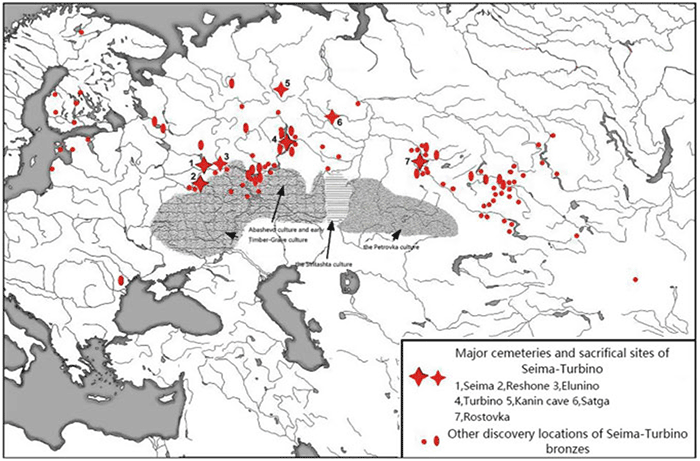
Seima-Turbino materials represent the eastward spread of Abashevo metallurgy (Carpelan and Parpola 2001), later visible in the emergence of the Andronovo-like cultural horizon. This Abashevo-related expansion beyond the Urals and its tight interaction with the paradigmatic PIIr.-speaking Sintashta-Potapovka have been confirmed in population genomics, with the gradual replacement of the preceding Pre-PIIr.-speaking Poltavka steppe herders (of predominantly Yamnaya stock) by Middle Bronze Age ancestry and patrilineages proper of the Corded Ware population, also visible in the strong substratal influence on the evolution from PIE to PIIr.
Subsequent layers of “Pre-PIr.” or PIr. loans – some of them reaching up to Pre-PFi. – were probably mediated by the continuation of the Eurasian Metallurgical Province in the form of the Late Bronze Age Srubnaya-Andronovo horizon and its northern interaction with groups of textile ceramics in North-Eastern Europe, and the Andronovo-like horizon in the Trans-Urals, but also later with the westward expansion of Pre-Scythian and Scythian nomads (with ‘Pre-Alanic’ loans) throughout the Eurasian steppes and their interaction with groups from the forest-steppes and forests on both sides of the Urals.
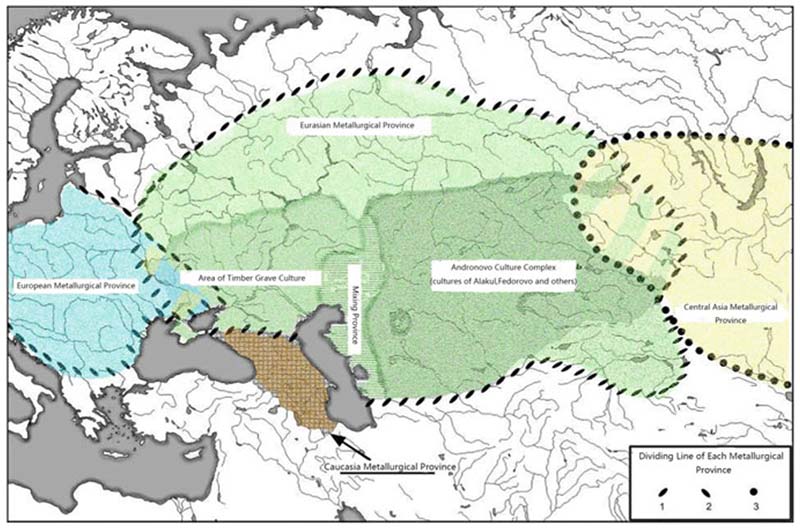
References
See full Bibliography.
Color code for protoforms
- certain | uncertain
- PU/PFU | PFP/PWU/PFS/PFV/PUg.| Dialects
- PIE (PIU?) | PIE? (PIU??)
- PIE/Pre-PIIr. (PIU??) | Pre-PIIr. | PIIr. | PIr.
- NWIE | Pre-PGmc./(Pre-)PBSl. | PGmc./PBal./(Pre-)PSlav.
- Substrate | Substrate?
- Agricultural: PU | PU? | PIE | PIIr.
- Geminates | Eurasian (Wanderwort?)
- Palaeo-European | Palaeo-Laplandic/Arctic
Return to the sections above: ↑ 10. Metallurgy or ↑ 11. Mythology.
Featured image: Erdal-Bilderreihe Nr. 116 Bild 3, Die Schnurtöpfer 2 by Gerhard Beuthner (1937).